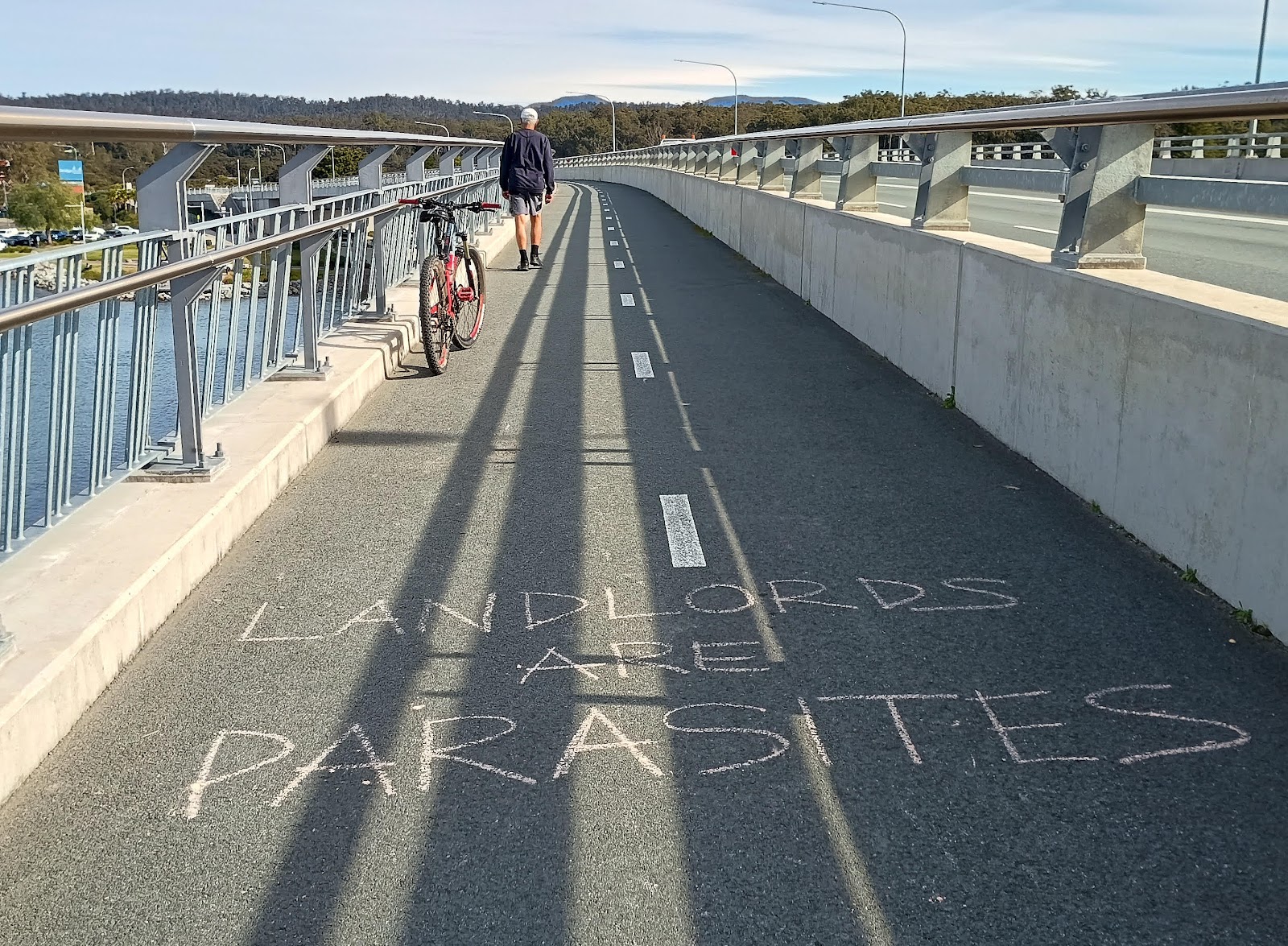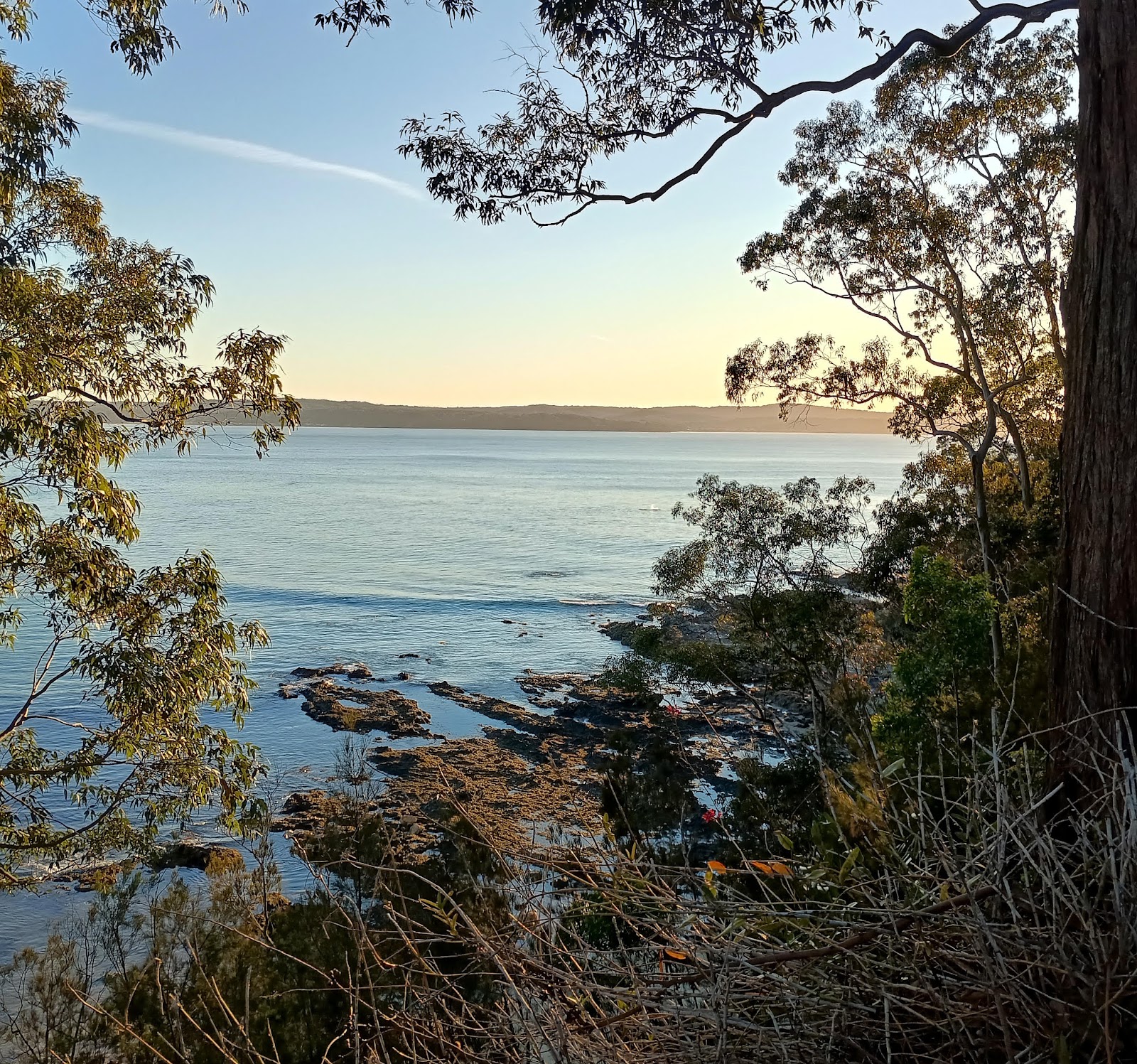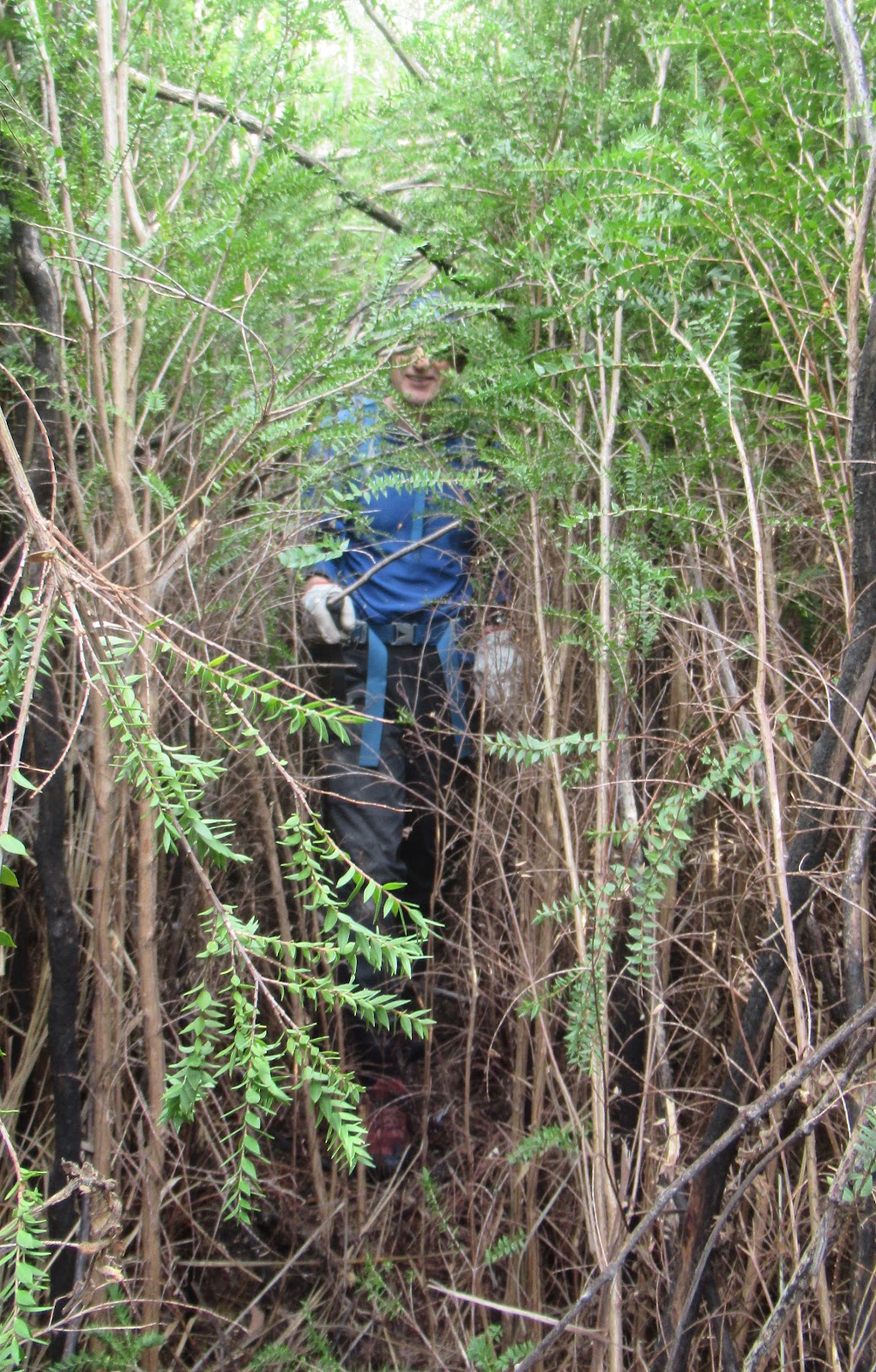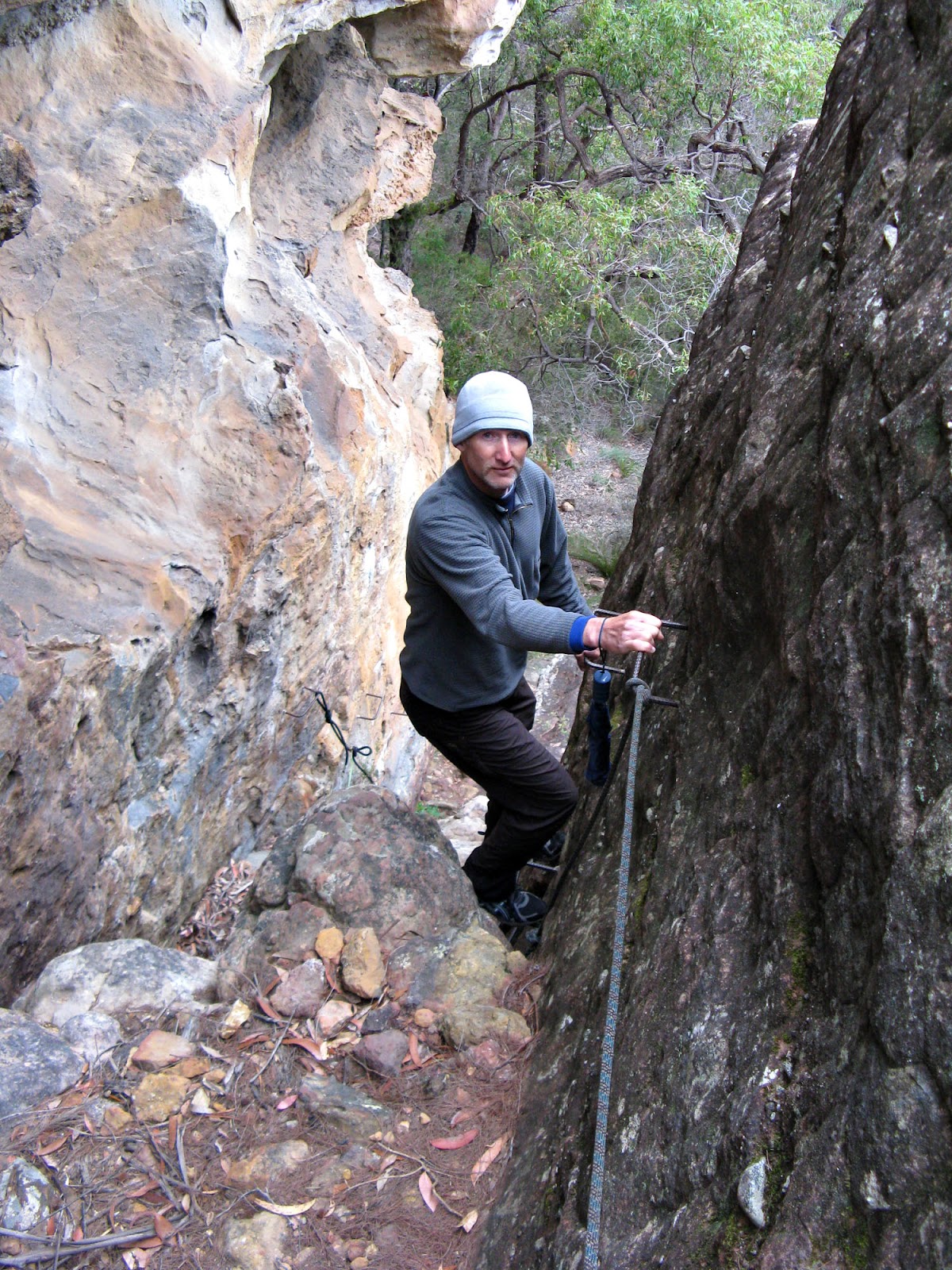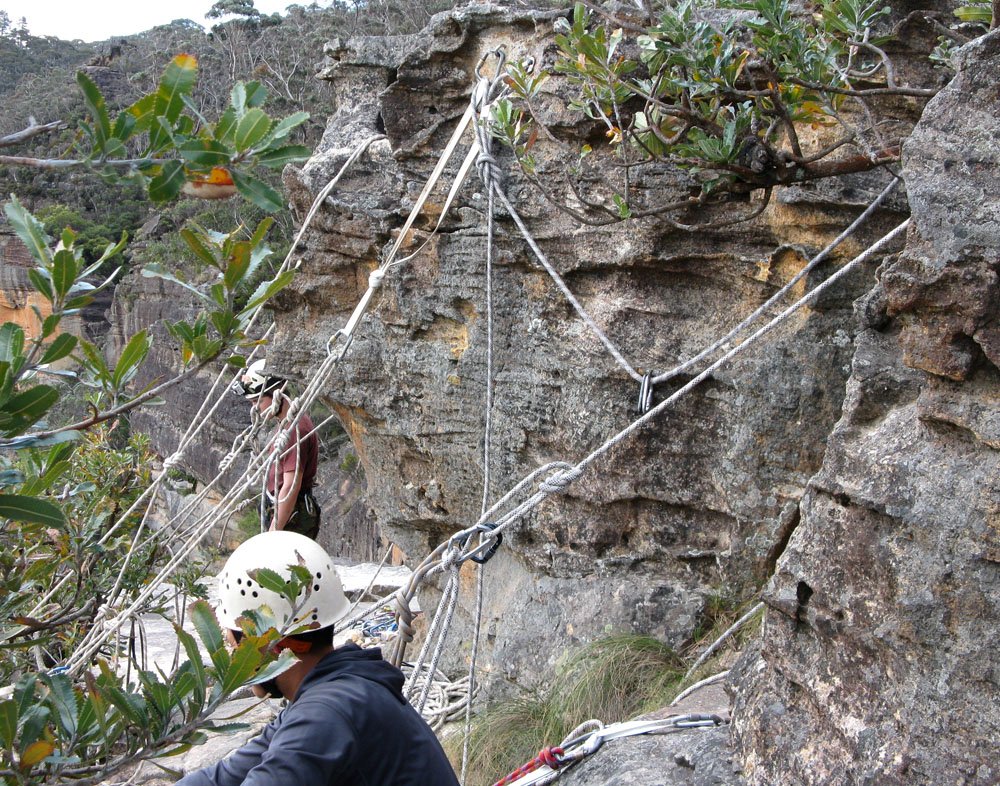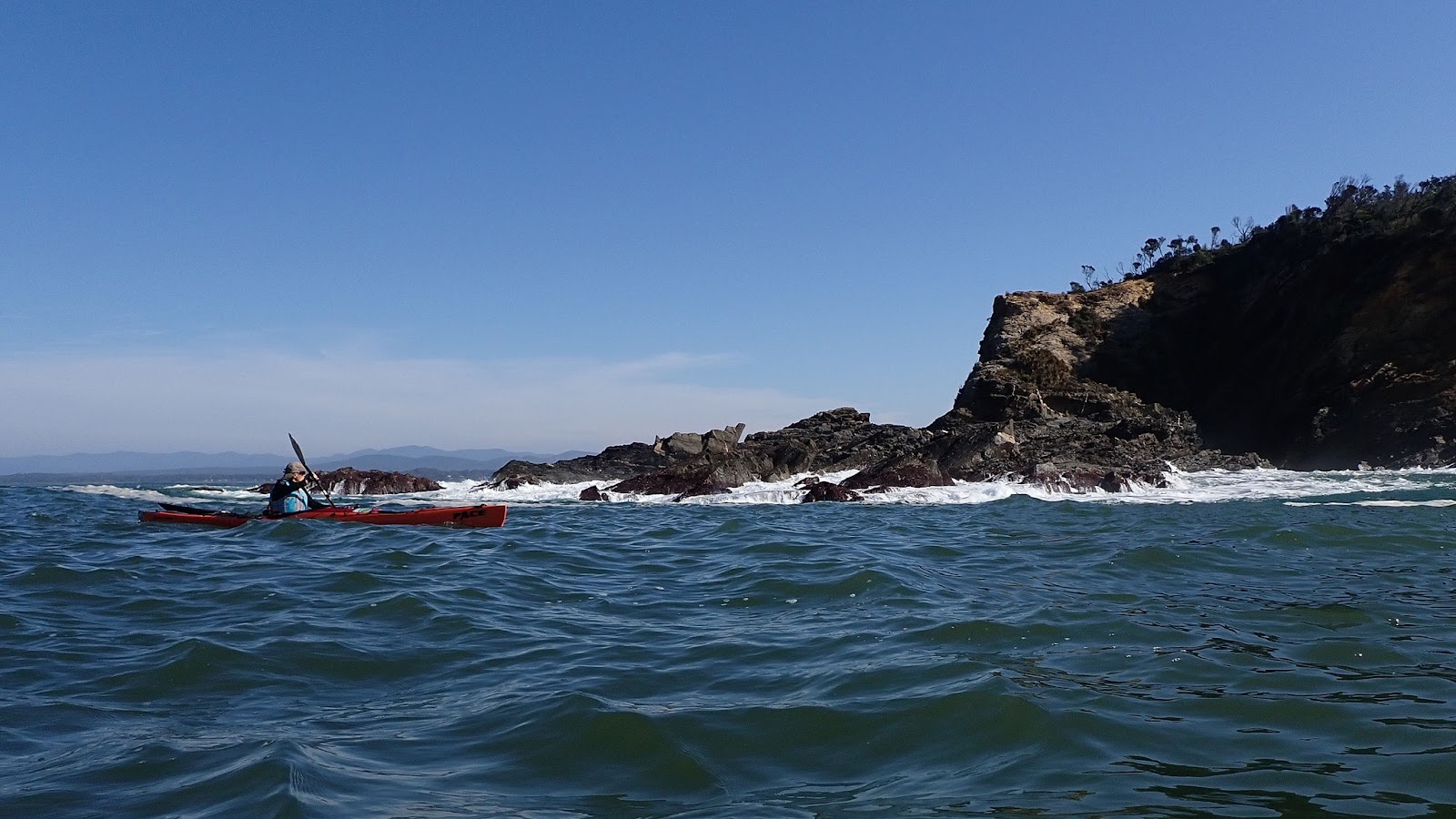Camping at Aragunnu.
Wednesday, July 30, 2025
A Week on the South Coast
Sunday, July 20, 2025
Not That Old Lady
There’s a vertical finger crack running up between two large cement pillars supporting the new Clyde River bridge at Batemans Bay. I had looked at them when cycling around the Bay a number of times and wondered if, like the Wide Boyz, I should start climbing urban cracks. I’ve never been a crack climber, the techniques, apart from jamming body parts in cracks, as mysterious as how electricity works to me, but the Wide Boyz make all cracks look easy, even the cellar cracks. It wasn’t easy, I couldn’t work it out. I got about a foot off the ground and that was using ripples in the cement for feet. “Needs work, perhaps some technique is missing,” I thought, jumping back on my bike and riding over to the north side of the bridge.
In running shoes, I sent the two problems on the biggest boulder at the new park, and cycled on to Cullendulla where I thought I might, but likely not as the tide was high, be able to cycle along the Cullendulla Nature Reserve track. When I got there, the beach was gone, as were most of the last remaining row of she-oaks along the shore line. Seven years ago, when we first moved to the Bay, there were lovely stands of she-oaks along the beach, but they have all toppled over, felled by storms and big tides. It’s inevitable, the landscape changes regardless of the hubris of humans who believe they can control the weather and tides.
I managed to drag my bike through a bunch of toppled tea-trees to far end of the “new” but now failed/never finished resort that was being built on this low lying, mangrove surrounded piece of land. The “glamping tents” built right against the shore, were all abandoned and the sea had clearly run far under their raised platforms. This was one of those farcical developments which you just can’t believe someone thought was a good idea and an entire committee of other elected individuals thought they should approve. At high tides, anyone staying in the “glamping” villas would have to wade through sea water to get out of their villas. Nothing says five star like putting your wellies on to walk to the cafe. It was no surprise to find the sign on the development indicating the “mortagee was in possession.” Shocker.
Back across the bridge, where the view to the Tollgate Islands is really quite spectacular, Purple Pingers had obviously been along as the pavement was decorated with the slogan “Landlords are Parasites.” Socialists, of course, need vacations too. Unfortunately, dragging my bike through the toppled bushes had caused a problem with the dropper post and I found myself having to ride home either sat on a too low seat with my knees around my ears or standing up. This reminded me of a long ago trip on the old BNR railway that ran from Salmo to Nelson when, not quite half way through a 50 kilometre bicycle ride my seat post snapped and I had to ride the final 30 kilometres with no bike seat. Lots of fun. I had the pannier carrier on the back of the bike imprinted on my arse by the time I finished the ride.
Passing the now closed wildlife park near Joes Creek, I noted, not for the first time, the painting on the water tank in the park, that proudly proclaims “You’re Somebody’s Someone.” This is the new level we have reached in public health messaging, the absurd idea that painting a trite slogan on a water tank will alleviate someone’s mental health distress. Now, I admit, I’m not your average bear, as Yogi said, but, if I were lonely and depressed, reading such a gormless piece of bull-shittery would make me feel even worse. It’s horrible to think about, but, there are many, many people in the world who aren’t somebody’s someone.
With low tide falling at the ideal time of day, around 7.00 am, I walked along the rock platforms from Sunshine Bay to Denhams Beach the next day. This is only possible at dead low tide as there are a couple of locations where you have to scramble right down to water level and balance across some slippery rocks uncovered by the tide. The “cruxes” of the route are around the headland that protrudes to the south west which happens to be one of the only places along the length of the coast here that has private land right to waterline. Many start this route, but, in all the times I’ve walked it, I’ve only seen one other person (besides Doug) make it right the way around. In a couple of spots, you have to climb up (or down, depending on which direction you go) short 2 to 3 metre walls, at least one of which is overhanging.
It’s only about three kilometres between the two beaches but it takes me twice as long as walking the trail as the rocks can be really slippery. I’ve never fallen on it, but, I did manage to have both my feet fly out from under me when descending the steep (and unofficial) stairs that lead down to a tiny pebbly beach on this day. As I slithered down on my bum - I actually thought I was going to slide all the way down to the bottom - some remnant memory of digging your feet in while self-arresting on snow must have trickled into my brain and I stopped. No bones broken, not even a graze. I would hate to be that old lady who breaks a hip on the stairs.
Tuesday, July 15, 2025
On The Seventh Day
On the seventh day, so goes the legend, God rested, I walked. For six tedious days I’ve been largely stuck in the house (did I mention I don’t do injury well?) except for a half hour walk and a one hour bicycle ride. This morning, everything felt strangely good, so I walked along the Munjip Track all the way to Wimbie Hill and back. It was glorious! A light frost on the ground when I left, but soon, sunny and calm and quiet along the beaches and the track. Ten kilometres, which isn’t a great deal but is 9.5 kilometres further than any other day this week, so I am stoked. And even more stoked to climb on my home wall with only a small twinge or two. Life is getting better and better.
Monday, July 14, 2025
The Commodification of Wild Places: Retreat is Not An Option
Be mentally strong. Suffer well. Kelly Cordes.
Cordes is hardly a household name, even among a household of climbers. But everyone has heard of “type two fun,” even if type two fun has been co-opted by the coddled generation to mean anything that caused you to break a sweat. Heck, even a bead of perspiration qualifies as type two fun in the age of micro-aggressions and trigger events. Cordes is the recipient of the American Alpine Club (AAC) Pinnacle Award in 2025 for outstanding achievements in mountaineering and was thus speaking to Provost on the AAC’s signature podcast.
It’s a great episode if you like Cordes – who I think is a quiet genius both as a climber/writer and as a thinker. One of those rare and brilliant individuals with little in the way of formal education (a bonus in the age of group think universities) who is as capable of spotting a stunning line to climb as they are of cutting through all the bullshit of modern society. In fact, Cordes almost convinces me that being a thinker and writer go hand in hand for what better way is there to process your thoughts and make sense of the world around you than to write about your experiences.
While the host acknowledges Cordes’ quirky (non PC) sense of humour, it’s not clear that she actually finds anything he says funny, but, then again, a middle class white woman in America is, statistically, more likely to have a psychological condition than to have a sense of humour. That’s not actually a joke, but it should be. For a taste of the trademark Cordes humour, have a read of this, published in Rock and Ice.
Alpine style represents minimalism, showing respect for the places that draw you there in the first place. Kelly Cordes.
We haven’t had minimalism in Australia for a few decades, most especially in public outdoor spaces where the move to over-engineer trails, “mitigate” risk, and reduce any real connection with the natural world has reached its acme. The amount of money and time spent to build short sections of track in Australia has reached mind-boggling levels. Case in point, three kilometres of trail in Sydney cost $9.5 million and took six years to complete! You might wonder if the trail was built with nail scissors, but, in reality, the first five years were probably the compilation of various health and safety reports followed by a year of laying down completely level boardwalk and the ubiquitous bakers dozen warning signs lest a traveller stub a toe.
Among states of absurdity, Victoria has reached dizzy new heights of retardation. While at the same time approving the installation of two via ferratas at Mount Buller (literally iron staircase), the government, under the auspices of the deranged Parks Victoria, has all but banned traditional climbing from Mount Arapilies. Keep in mind that via ferratas involve bolting and gluing iron rungs and cables into cliffs, while traditional climbing leaves no trace on the rock as the second climber removes the protection that the lead climber places. Apart from perhaps some chalk marks, which wash off in the rain, there is no sign of the climbers passage. By this logic, bolted and permanent iron ladder equals good, leave no trace climber equals bad.
What really is behind this extraordinary divestment of rational thinking as, even the loopy left that can’t distinguish men from women, can see that these two options are in direct contradiction to one another. In my mind, it comes down to two things, both of which socialists appear to resent. The first is freedom. Freedom to make my own decisions, take my own risks, and bear the consequences of my choices. The second is money! Climbers have always been known to be stingy bunch, willing to sacrifice all manner of luxury comforts to afford a new cam to fill out their rack. While Rock Wire at Mount Buller can charge almost $300 for a half day tour, rock climbing is essentially free. And therein lies the second orthogonal juxtaposition: socialist governments that love capitalist money making endeavours as long as they can cream their taxes off the top. Australia has entered the commodification of wild places and, like Cordes on the Azeem Ridge on Great Trango Tower, retreat is not an option.
Thursday, July 10, 2025
She Go Buggar Up
I shouldn’t be here right now. I should be somewhere along an overgrown track in Nattai National Park, but I’m home because I seem to have buggared myself up. Years and years ago, when I was 28 in fact, which is so long ago I can barely remember it, Doug and I paddled a double sea kayak around the Western Province of the Solomon Islands. The local people spoke – at least to us – a version of English called pidgin English, and the expression we loved most of all, was “she (or he – Solomon Islanders are open about gender) go ‘buggar up.’” Many things went buggar up around the islands, including, somewhat troublingly, aeroplanes and boats. Right now, my leg and hip have gone buggar up. It’s likely some soft tissue injury, which is both good and bad. Good to know my bones haven’t crumbled, bad because soft tissue injuries take so long to heal and are so prone to becoming chronic.
We were climbing at Nowra, during school holidays! I underlined that as we usually avoid school holidays but we have had so much rain lately that our climbing trips had been delayed and when good weather arrived I was keen to get out. There was a crowd, an ever-changing crowd, the likes of which I have not seen since we used to climb in Canada and the USA. People came, climbed a pitch or two, left or moved on. Doug and I stayed where we were and simply moved along the routes. We both like this, it’s efficient and you get lots of climbing in. We also frequently climb the routes twice. Back in the day, people used to do this quite often, in fact people often used to down-climb routes. Down-climbing, like trad climbing, is a bit of a forgotten skill but can be really handy if you need to retreat off a route. Doug once down-climbed an entire route in Joshua Tree from the very top removing his gear as he went! It was impressive. The reason we climbed routes twice, and continue to do so, was to perfect your movement after the first time up. It’s an old habit and, despite changing norms, a worthwhile habit. Sometimes old stuff works so well you don’t need to replace it with new stuff.
Any time a crag is crowded weird shit will be going on. Some of it feels slightly unsafe, some sketchy, some downright dodgy. A father and daughter were climbing, Dad leading and outweighing the daughter by about 40 kilograms, with daughter belaying with an ATC. We are in an age where you expect everyone sport climbing to have a gri-gri or similar assisted braking device but ATC’s, like hexes, still float around the Australian climbing scene. Dad admitted to being slightly sketched on a couple of routes “What,” I pondered “would happen if Dad took a lead fall?” Things might go buggar up.
A few adults with a few dogs and children were belaying the children on two routes separated by a route in between. They had only one rope, so one end of the rope went up to a bell-ringer belay through one set of anchors, while the other end of the rope did the same to a second set of anchors a couple of metres away. The rope was too short for both child-climbers to be on the ground at the same time. So one child would climb up until the short end of the rope on the second climb had extended far enough to tie the other child in to start climbing. Then both children would climb with separate adults belaying them. If one child wanted to come down, they could only reach the ground if the second child climbed high enough to allow the rope to reach the ground.
An inventive use of one rope or potentially open to something dodgy or even a situation where everything went buggar up? Both climbers were light, the rope was used in a top-rope scenario only so not a lot of force on the rope (force = mass x acceleration, both low in this instance), but what happens if both children are unable to proceed up the different climbs and want to come down at the same time? It was vaguely disquieting but, like most things we do, proceeded without catastrophe. Does that make it a good idea? I’m not sure because it’s not entirely clear cut. When not climbing, the children were happily engaged in the sort of improvised play – moving rocks about in the dirt – that children everywhere excel at, so there seemed no reason to have the children continually involved in climbing. In fact, the children were largely uninterested in climbing, the rocks and dirt appeared to hold more appeal. Is that vague disquiet a sign that this unconventional approach is dodgy, or simply a lack of familiarity with the situation? What would happen if it all went buggar up?
In complex situations, and rock climbing, even in a top-rope situation is complex, I often think the best thing to do is revert to the simplest possible solution. In the above instance: one rope, one belayer, one anchor, one climber. Simple allows everyone to see at a glance that the basic tenets of safety have been attained and does not require complex thinking each time the climber switches out. This is why I find the increasingly complexity often displayed on social media sites (frequently canyoning for some reason?) worth ignoring. After all, no-one wants to find themselves in a situation where everything has gone buggar up.
Monday, July 7, 2025
Relinquishing Comforts
I think women are more risk averse, in general. Sarah Hueniken.
My fifth - sixth if you count the Solstice weekend as two separate trips - NSW Sea Kayak Club Sunday Paddle. Again, the weather was really good: light winds, a swell around 1.5 metres, and even sun! It was considerably warmer than the previous Sunday when Robbie had kept me out until way past my lunch time, but I was still out way past lunch time. Doug and I paddled down to Wimbie Beach to meet Robbie and Dave, and then out to Black Rock, straight south to Burrewarra Point and then a tour of all the beaches and bays until we got back to Wimbie Beach where we dropped off Robbie and Dave before returning to our home beach where the swell was washing far up the beach. Thirty kilometres because my 20 kilometre winters day limit seems to have been washed away along with all the sand on our local beach.
This film is a couple of years old but Hueniken’s kind of badassery is timeless. The back story of Hueniken’s link up is the tragic and completely unexpected avalanche that resulted in the death of one of her best friends along with the partial burial of one of the clients. In the small world that is the climbing community, one of the other women on the course is an aspiring mountain guide and daughter of a friend of mine back in Canada, so I knew of the accident and also knew how tough the situation was for the women who survived.
These kinds of accidents are as titillating to the public as they are rare, and, also, frequently deeply misunderstood. Everyday the average person engages in a dozen activities (eating processed food, driving, drinking alcohol, smoking, sitting on the couch all day, taking 6 or 7 clot shots, doom scrolling ABC fear porn, and so on) which will slowly but surely shorten their life span and/or health span yet these risks are accepted, or more perhaps more accurately, under-rated and ignored.
Situations that are immediately life threatening are so rare in the modern world that the average person has no good metric with which to deal with such events. The normative response, as life gets more regulated and society as a whole becomes more risk averse, is to find someone to blame. That blame frequently lies with the guide, but this has always seemed like sloppy thinking to me as any accident that occurs in a mountain environment is as risky to the guide as it is to the client. There’s not a mountain guide alive who goes out to work in the morning thinking “This is a good day to die. I think I’ll take all the clients with me.”
When the inevitable survivor begins the seemingly vengeful search for blame, it’s hard not to think: “There is no adventure without risk. You signed up for this willingly, if not eagerly.” I sometimes wonder if the only people who understand real risk are the people who have lost friends to mountain accidents or been involved in too many incidents and close calls of their own to maintain any semblance of deniability.
Thursday, July 3, 2025
Going Too Far
So a new thing in the outdoor world just dropped: stress injury. Like most of the new things, stress injury can be anything and everything, which might seem like a flaw, but most certainly is a feature. The broader the definition, the more people can be caught up in the web of diagnosis, disorder, and, even disability. If you are unlucky enough to have escaped the myriad diagnoses already available: depression, social anxiety disorder, ADHD, neurodivergence; stress injury may be just the diagnosis you are looking for. After all, as the “expert” says in the podcast: “if you are impacted by stress you are injured by it.” Everyone, even the most laid back and secure individual on the planet is impacted by stress, which is absolutely brilliant business model.
If you are unconvinced of my precis, the host of the podcast, introduces herself by saying “I actually have a stress injury from this podcast.” Cue the awkward tittering laughter from the audience as, at least some people recognise, that this is a dubious proposition. However, only a handful of the 75 audience members giggle, and, in the face of social disdain - one of the most powerful human motivators is group cohesion - the laughter quickly dies away. Perhaps, one person in the room, continues to think “this doesn’t sound right,” but, it’s likely that the prospect of being in the out-group is enough to quell any dangerous non-group think. When I heard the tittering laughter, I was reminded of the Lia Thomas affair, when the entire sporting world, told us to believe that the broad shouldered 186 cm tall, obviously male, swimmer was actually a woman and could thus compete against other women in swimming events. We may not be in a simulation, but we are certainly living through Hans Christen Anderson’s “The Emperor Has No Clothes” wherein we are asked to believe things that are patently absurd.
But such is the nature of humans, we always go too far. Whether it is psychological diagnosis or the ever expanding gender categories. What starts out reasonable quickly becomes a Medusas head that is impossible to control or tame. This is not to say that some people are not severely affected by tragic incidents in their life. Of course, extreme stress does produce extreme injuries, but we do a disservice to the truly suffering when we inflate discomfit with disease. As with humans, so with nature and Australia’s typical weather. When storms come, they frequently go too far, with not just 30 or 50 mm of rain but 350 mm of rain.
The east coast of Australia is slowly emerging from another East Coast Low. As strong as a category one cyclone, was reported by the Bureau of Meteorology, but, as Australia descends deeper and deeper into a country of incapable victims, I had to wonder if this was simply more hysterical reporting to frighten an already cowed population into compliance. At the house, we got about 150 mm of rain, and it was windy, but less so than other events, and, out and about over the two or three days of the storm, I saw big seas and storm surges but, at least to my comparative eye, the wind, rain and swell were slightly less than other similar events.
The photos in this post are all taken from a walk around some local headlands. Most are from Burrewarra Point where, after years of wondering why the locals didn’t have some kind of trail that lapped around the headland – it’s all public reserve – I stumbled upon a little foot-pad (somewhat obliterated by fallen trees after this last ECL) that circled the headland and even provided scramble access to a couple of small, wave washed shingle beaches.













